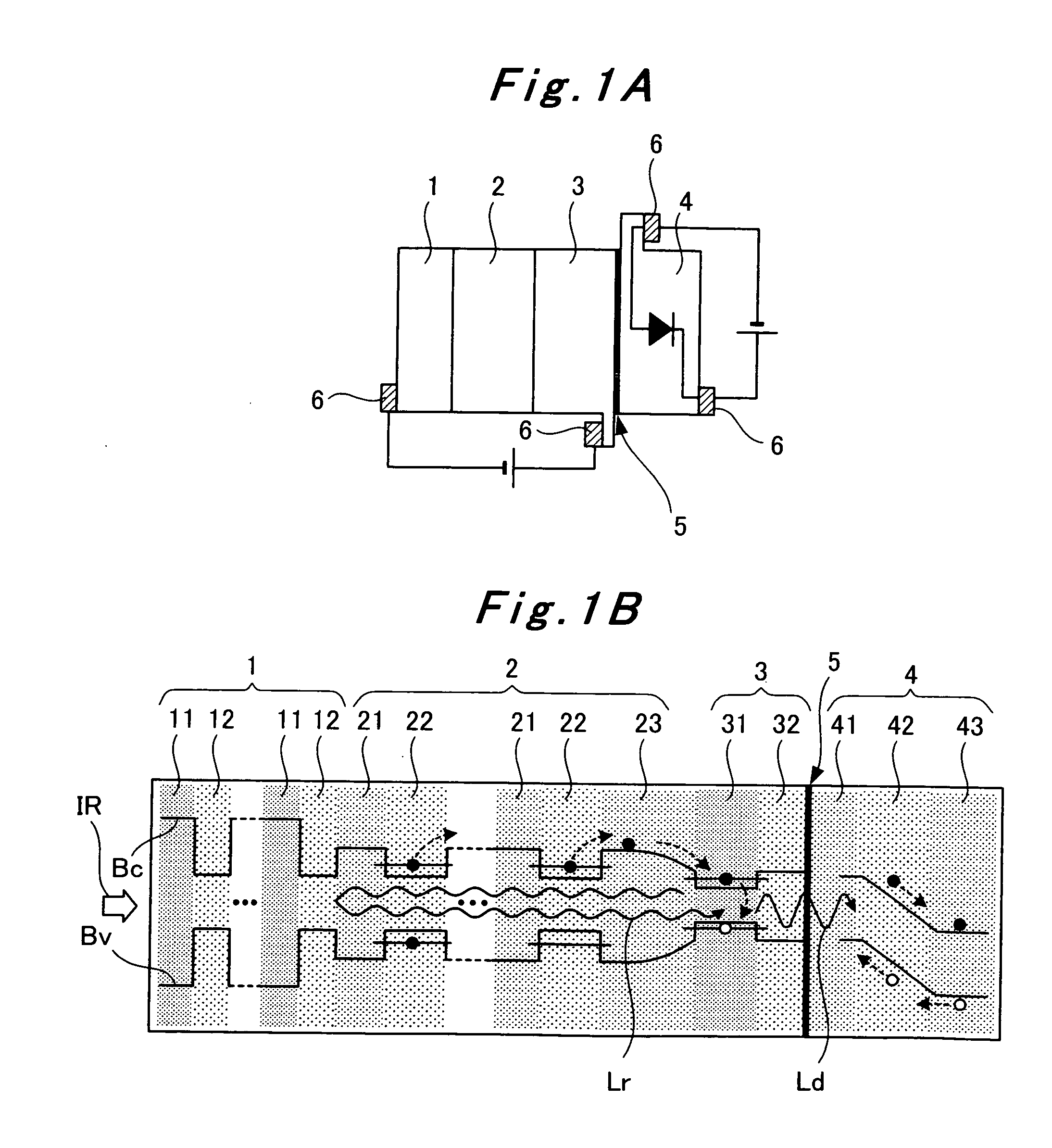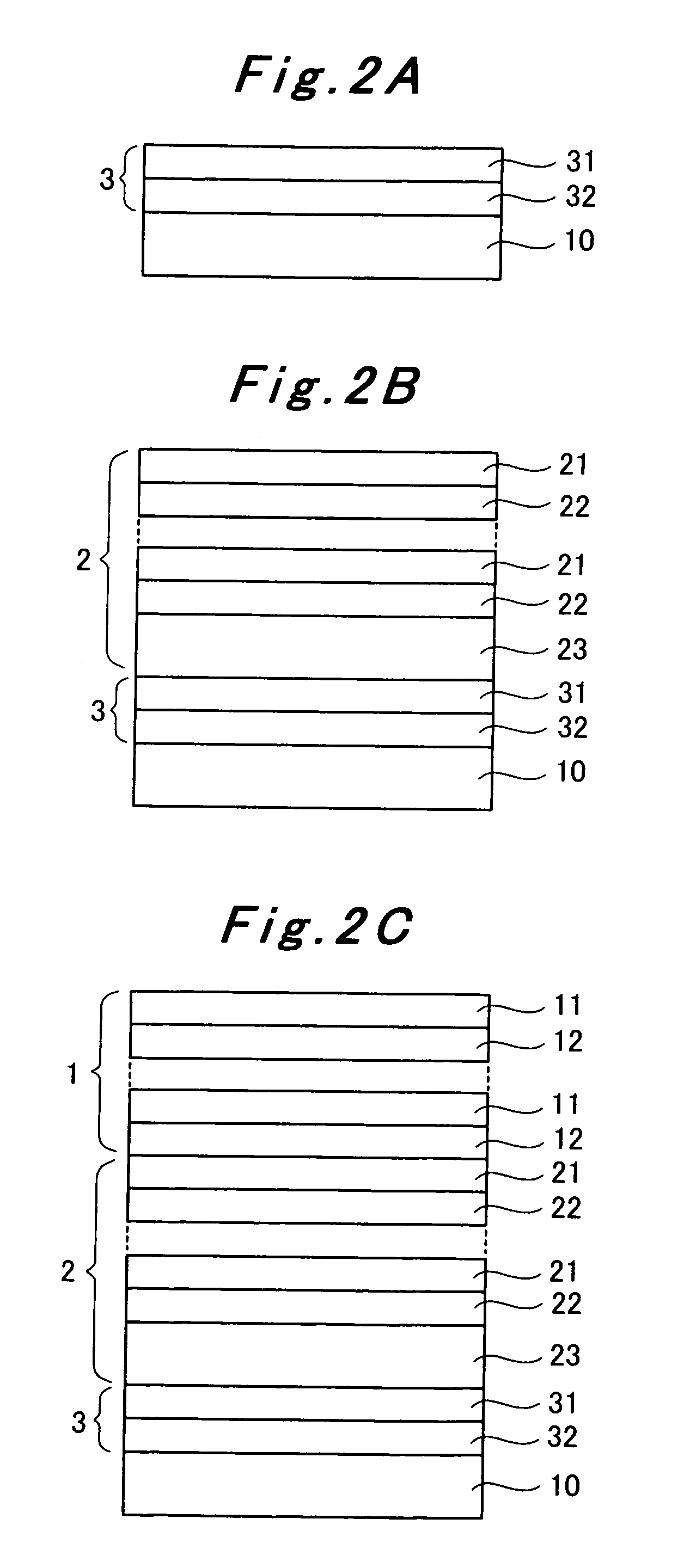Infrared detector, infrared detecting apparatus, and method of manufacturing infrared detector
a technology of infrared detectors and detectors, which is applied in the field of infrared detectors, can solve the problems of difficult growth of high-quality crystals, poor yield, and inability to obtain high-quality substrates with a large area, and achieves the effects of simple structure, improved detection sensitivity, and high efficiency
- Summary
- Abstract
- Description
- Claims
- Application Information
AI Technical Summary
Benefits of technology
Problems solved by technology
Method used
Image
Examples
embodiment 1
[0047]FIGS. 1A and 1B are diagrams describing an infrared detector according to a first embodiment of the present invention. FIG. 1A is a diagram describing, schematically, the configuration of the infrared detector. FIG. 1B is a diagram describing the structure of the infrared detector and the energy bands thereof. FIGS. 2A to 2C are diagrams describing a method of manufacturing the infrared detector.
[0048]As FIG. 1A illustrates, the infrared detector of Embodiment 1 includes a first element and a second element that are bonded together with a bonding portion 5 so as to form an integrated body. The first element includes a reflection portion 1, a photo-current generating portion 2, and a light emitting portion 3. The reflection portion 1 transmits rays in the far-infrared range and in the middle-infrared range, but reflects rays in the near-infrared range and in the visible range. The photo-current generating portion 2 has a multiple quantum well structure. In the multiple quantum ...
embodiment 2
[0082]FIGS. 4A and 4B are diagrams describing an infrared detector according to a second embodiment of the present invention. FIG. 4A is a diagram describing, schematically, the configuration of the infrared detector. FIG. 4B is a diagram describing the structure of the infrared detector and its energy bands. FIGS. 5A to D are diagrams describing a method of manufacturing the infrared detector. Note that in the following description those constituent elements of the infrared detector of Embodiment 2 that have their respective counterparts in the infrared detector of Embodiment 1 are denoted by the same reference numeral.
[0083]As FIG. 4A illustrates, the infrared detector of Embodiment 2 includes a reflection portion 1, a photo-current generating portion 2, a light emitting portion 3, and a photo-detecting portion 7. The reflection portion 1 transmits rays in the far-infrared range and in the middle-infrared range, but reflects rays in the near-infrared range and in the visible range...
embodiment 3
[0120]FIG. 6 is a diagram describing an infrared detector according to a third embodiment of the present invention. Note that the content of Embodiment 3 is implemented on the basis of the infrared detector of Embodiment 2, so that in the following description those constituent elements of the infrared detector of Embodiment 3 that have their respective counterparts in the infrared detector of Embodiment 2 are denoted by the same reference numeral. Needless to say, the content of Embodiment 3 can be implemented on the basis of the infrared detector of Embodiment 1.
[0121]As FIG. 6 illustrates, the infrared detector of Embodiment 3 includes a refraction layer 8 located on the incident surface side. The refraction layer 8 refracts the incident angle of the incident rays in the far-infrared range and in the middle-infrared range that enters perpendicularly the incident surface. Specifically, the refraction layer 8 made of GaAs is formed, firstly, through the crystal growth carried out b...
PUM
 Login to View More
Login to View More Abstract
Description
Claims
Application Information
 Login to View More
Login to View More - R&D
- Intellectual Property
- Life Sciences
- Materials
- Tech Scout
- Unparalleled Data Quality
- Higher Quality Content
- 60% Fewer Hallucinations
Browse by: Latest US Patents, China's latest patents, Technical Efficacy Thesaurus, Application Domain, Technology Topic, Popular Technical Reports.
© 2025 PatSnap. All rights reserved.Legal|Privacy policy|Modern Slavery Act Transparency Statement|Sitemap|About US| Contact US: help@patsnap.com



